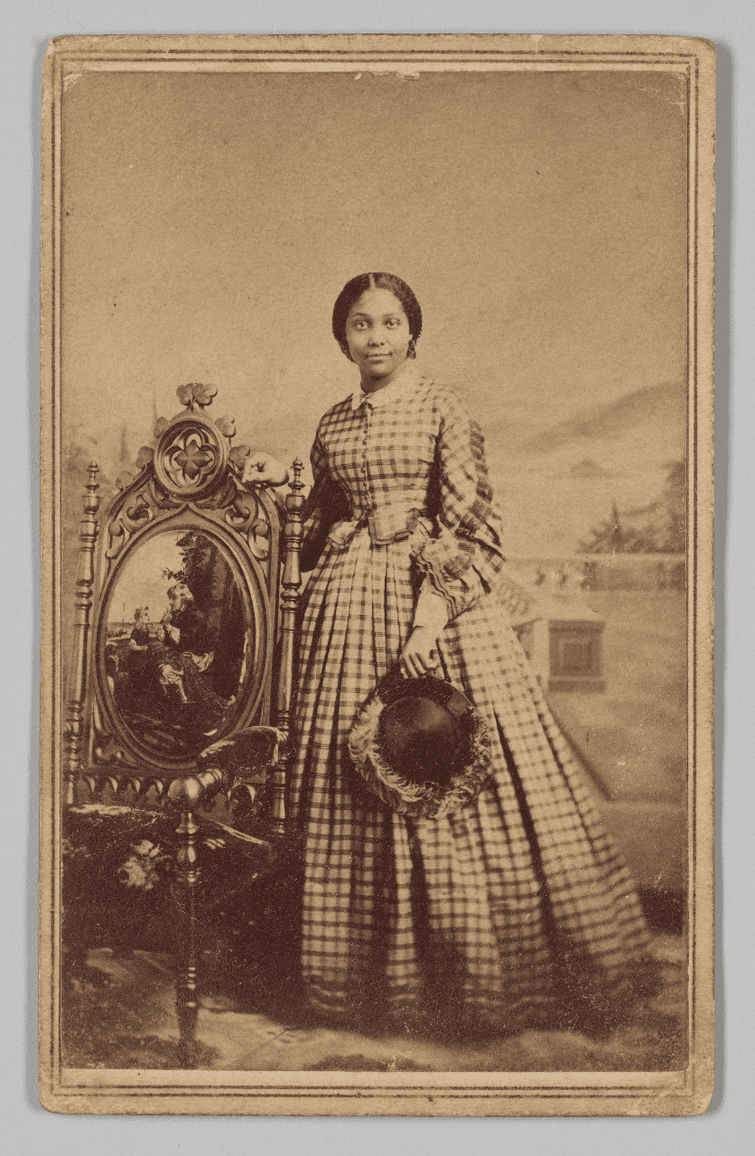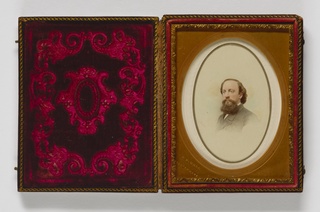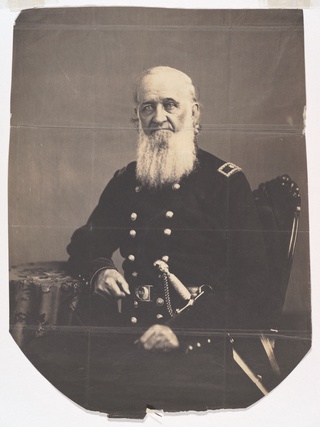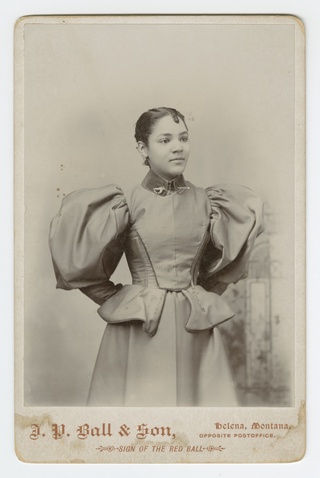Bearing Witness: James Presley Ball, Black Image Making, and the Promise of Freedom in the American West
By keondra bills freemyn•August 2024•7 Minute Read

J. P. Ball & Son, Carte-de-visite portrait of a young woman, c.1860. National Museum of African American History and Culture, public domain. A sepia tone carte-de-visite of a young woman, captured at the Ball & Thomas Photographic Art Gallery in Cincinnati, OH.
African-American photographer and abolitionist James Presley Ball’s portraits document the experiences of early settlers in the Great Plains region. Ball’s images of Black settlers offer a view into the social and professional lives of a community seeking refuge and upward mobility on the frontier.
Introduction
African American photographer James Presley Ball dedicated his career to witnessing and recording the plight and joy of Black people in the American West as they sought refuge from the horrors of the post-Emancipation South. Over a century since his death, Ball’s work continues to influence contemporary portraiture, Black self-image, and the reimagining of identity through the photographic medium.
Art and Abolition
J.P. Ball’s artistic practice was imbued with a belief in the possibility of liberation for Black people within his lifetime. Despite being born free in Virginia in 1825, Ball chose to use his art and influence as an esteemed artist and community leader towards the emancipation of the enslaved.1
James Presley Ball, Portrait of Alexander Thomas, c.1851–1859. Cinccinati Museum Center, CC0. Alexander Thomas operated a joint photography studio, Ball & Thomas, with J.P. Ball from 1857-1860.
Trained in the daguerreotype format by early African American portraitist John B. Bailey, Ball began his career as an itinerant photographer before opening a one-room portrait studio in Cincinnati in the 1850s.
Illustration of James Presley Ball’s Great Daguerrian Gallery of the West, 1854. Frederick Douglass' Paper, public domain. The gallery was adjacent to Ball’s Cincinnati photography studio and showcased fine art and photography.
In advertisements for his studio, Ball differentiated himself from local competitors by emphasizing his portraits as “durable,” “lifelike,” and “the cheapest.”2 The portrait studio grew to include multiple rooms, including a daguerreotype gallery that journalists described as “the most famous” and “most ornate” in the Midwest.3 Ball’s studio, with its gallery of photographic portraits and paintings, including works by landscape painter Robert S. Duncanson, was noted in a newspaper article as a “flourishing business“ and “one of the best answers to the charge of natural inferiority” often leveled at Black Americans.4
James Presley Ball, Portrait of Frederick Douglass, 1867. Cincinnati Museum Center, CC0. Douglass is one of many public figures who sat for portraits in Ball’s studio.
Ball is believed to have photographed Queen Victoria in 1856 during a visit to Europe.5 He welcomed other notable sitters including abolitionist writer Frederick Douglass, Union Army General Melancthon S. Wade, and novelist Charles Dickens to his studio. Ball’s daguerreotype works from this era evoke a sense of intimacy accentuated by delicate lighting and subtle backdrops. Though none of Ball’s daguerreotypes with color remain, his technique of adding hand-painted details contributed to his reputation for exemplary artistry.6
In 1855, Ball enlisted Duncanson to create a 600-yard wide panorama depicting vivid scenes of the horrors of slavery. Titled Ball’s Splendid Mammoth Pictorial Tour of the United States, the painted canvas scroll featured 53 scenes showcasing the barbarity of slavery alongside details of resistance movements and the cultural richness of enslaved people’s West African origins.7
Portrait of James Presley Ball, n.d. Cincinnati Museum Center, CC0. Portrait of Ball in middle age.
Ball presented the piece across the country, accompanied by a 56-page narrative description, urging viewers to take action to end slavery. Unveiled a decade before Abraham Lincoln issued the Emancipation Proclamation in 1963 and the ratification of the 13th Amendment to the U.S. Constitution in 1965, the panorama was Ball’s attempt to record “plain facts for plain people.”8 As a photographer of dignitaries as well as the general public, he understood that liberation work was the responsibility of the masses—not just that of the political and economic elite.
A New Format and the Promise of Freedom
James Presley Ball, Portrait of an unidentified African American woman, c.1887–1900. Montana Historical Society Library and Archives, educational use permitted. A vignette carte-de-visite portrait of a Montanan woman.
In the late 1850s, Ball moved away from the daguerreotype process and began printing cartes-de-visite, albumen prints on lightweight and portable cards. Whereas daguerreotypes were unique images backed by thin sheets of copper, the albumen process allowed photographers to create multiple prints from a single negative. Paper prints were more affordable, allowing a broader range of patrons to document their lives and families.
J. P. Ball & Son, Carte-de-visite portrait of a young woman, c.1860. National Museum of African American History and Culture, public domain. A sepia tone carte-de-visite of a young woman, captured at the Ball & Thomas Photographic Art Gallery in Cincinnati, OH.
The adoption of less expensive, portable paper photos shifted artistic possibilities and changed the cultural role of photography from a home- or gallery-based practice to a social one. Ball’s daguerreotypes feature seated subjects, due in part to the longer exposure times the process required. His paper-based works capture sitters in a range of situations, providing additional personal and cultural context of the social and professional lives of African Americans during the Reconstruction era. Black sitters are seen posing with friends and pets, in full work and military uniforms, and in society regalia.
James Presley Ball, Portrait of an unidentified African American man, c.1890. Montana Historical Society Library and Archives, educational use permitted. The yoke and apron worn by the sitter likely indicate affiliation with the Grand United Order of Odd Fellows, a predominantly African American fraternal organization.
James Presley Ball, William C. Irvin, policeman, c.1888–1891. Montana Historical Society Library and Archives, educational use permitted. Carte-de-visite portrait of Irvin wearing a police uniform and white gloves.
The increased dissemination of imagery that reflected the prosperity of born-free and formerly enslaved African Americans spurred a new era of photography as a tool for cultural change. Despite legal bondage being outlawed and some new opportunities, Black people still faced the realities of segregation and Jim Crow laws that limited their upward mobility. Bolstered by the Homestead Act and the possibility of less racialized mistreatment, a small group of African Americans settled in the Great Plains region, then considered to be the western frontier. In 1887, Ball left Cincinnati for the Great Plains, settling in Helena, Montana Territory, prior to the area’s statehood.
Photographs from Ball’s Helena studio offer rare glimpses into the personal lives of the population of early settlers of the Great Plains. Ball’s sitters included dignitaries and community members across racial identities, as well as military officers and veterans. The aesthetics of his work during this time reflect the confidence and pride of African American sitters who were navigating a post-emancipation reality. The images show an array of familial relationships, occupations, and sartorial styles, documenting the beauty of everyday life. In Portrait of unidentified African American men with dog, two men pose for a studio portrait that reflects their recreational lives. Many of the extant images produced in Ball’s studio during this period depict subjects in formal dress, uniforms, and regalia. The image of men with a dog is an anomaly that offers a rare glimpse into a more quotidian experience.
James Presley Ball, Portrait of unidentified African American men with dog, c.1887–1890. Montana Historical Society Library and Archives, educational use permitted. A rare studio portrait of African American men posing with a pet.
Ball became involved with African American social organizations and political movements in Helena. In these years, he ran for office in the Republican party, was a delegate to the party convention in 1894, and served as president of Montana’s Afro-American Club and cofounded the St. James AME Church, while continuing to operate his photography studio with the help of his daughter, son, and daughter-in-law.9 10
A Continuing Legacy
Ball is an early example of African American artistic excellence and entrepreneurship. His practice and portraiture represent the possibility of independence and self-actualization in image making.
In the decades following Ball’s death, social and political changes in the country contributed to expanding documentation of Black people across the nation. Ball would not live to see the flourishing of Black-owned studios like the Scurlock Studio in Washington, D.C. or that of James Van Der Zee in Harlem. However, Ball’s intimate portraiture is dynamic precursor to 20th century photography, capturing both the resilience and glamor of African Americans in a nation not yet ready to contend with their full humanity.
keondra bills freemyn is a 2024 Curationist Critic of Color. She is a DMV-based archivist, writer, Wikipedian, and former diplomat originally from South Central, Los Angeles. keondra serves as Archives Director at Black Lunch Table, a radical archiving project centering Black visual artists and operates the small press 67th Street Storytellers. A poet, essayist, and scholarly writer, she is author of the poetry collection Things You Left Behind and is founder of Black Women Writers Project, a digital archival initiative highlighting the contributions of Black women and gender-expansive writers to the literary canon. Her research interests include digital archiving, memory work, and Black cultural production.
Citations
Ketner, Joseph D., II. “Struggles many and great: James P. Ball, Robert Duncanson, and other artists of color in antebellum Cincinnati.” The Magazine Antiques, 30 November 2011, http://www.themagazineantiques.com/article/ketner-james-p-ball-robert-duncanson-antebellum-cincinnati/. Accessed 21 June 2024.
Willis, Deborah. J.P. Ball Daguerrean and Studio Photographer. Garland Publisher, 1993, p. xv.
Rinhart, Floyd and Marion Rinhart. The American Daguerreotype. University of Georgia Press, 1981, p. 140.
Willis, xv.
Willis, xvi.
Ketner.
Ball, James Presley. Ball's Splendid Mammoth Pictorial Tour of the United States: Comprising Views of the African Slave Trade; of Northern and Southern Cities; of Cotton and Sugar Plantations; of the Mississippi, Ohio and Susguehanna Rivers, Niagara Falls, Cincinnati. A Pugh, 1855, Table of Contents.
Ball, Preface.
Willis, xviii.
D’Ambrosio, Brian. “James Presley Ball: Renowned Black Photographer in Helena.” Distinctly Montana, 15 June 2017, http://www.distinctlymontana.com/james-presley-ball. Accessed 12 August 2024
keondra bills freemyn is a 2024 Curationist Critic of Color. She is a DMV-based archivist, writer, Wikipedian, and former diplomat originally from South Central, Los Angeles. keondra serves as Archives Director at Black Lunch Table, a radical archiving project centering Black visual artists and operates the small press 67th Street Storytellers. A poet, essayist, and scholarly writer, she is author of the poetry collection Things You Left Behind and is founder of Black Women Writers Project, a digital archival initiative highlighting the contributions of Black women and gender-expansive writers to the literary canon. Her research interests include digital archiving, memory work, and Black cultural production.


